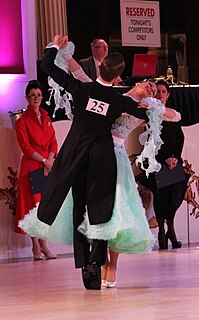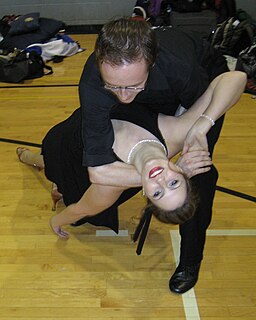
Ballroom dance is a set of partner dances, which are enjoyed both socially and competitively around the world. Because of its performance and entertainment aspects, ballroom dance is also widely enjoyed on stage, film, and television.
In partner dancing, connection is a physical communication method used by a pair of dancers to facilitate synchronized dance movement, in which one dancer directs the movements of the other dancer by means of non-verbal directions conveyed through a physical connection between the dancers. It is an essential technique in many types of partner dancing and is used extensively in partner dances that feature significant physical contact between the dancers, including the Argentine Tango, Lindy Hop, Balboa, East Coast Swing, West Coast Swing, Salsa, and Modern Jive.
In some types of partner dance, lead and follow are designations for the two dancers' roles in a dance pairing. The leader is responsible for guiding the couple and initiating transitions to different dance steps and, in improvised dances, for choosing the dance steps to perform. The leader communicates choices to the follower, and directs the follower by means of subtle physical and visual signals, thereby allowing the pair to be smoothly coordinated.

Viennese waltz is a genre of ballroom dance. At least four different meanings are recognized. In the historically first sense, the name may refer to several versions of the waltz, including the earliest waltzes done in ballroom dancing, danced to the music of Viennese waltz.

Salsa is a Latin dance associated with the music genre of the same name which originated in the 1960s in New York City. Salsa is an amalgamation of Cuban dances that were popular in the ballrooms and nightclubs of Havana by the end of the 1950s, as well as American jazz dances. It was primarily developed by Puerto Ricans living in New York (Nuyoricans) in the late 1960s and early 1970s. Different regions of Latin America and the United States have distinct salsa styles of their own, such as Cuban, Puerto Rican, Cali Colombia, L.A. and New York styles. Salsa dance socials are commonly held in nightclubs, bars, ballrooms, restaurants, and outside, especially when part of an outdoor festival.
The parallel turn in alpine skiing is a method for turning which rolls the ski onto one edge, allowing it to bend into an arc. Thus bent, the ski follows the turn without sliding. It contrasts with earlier techniques such as the stem Christie, which slides the ski outward from the body ("stemming") to generate sideways force. Parallel turns generate much less friction and are more efficient both in maintaining speed and minimizing skier effort.

The butterfly is a swimming stroke swum on the chest, with both arms moving symmetrically, accompanied by the butterfly kick. While other styles like the breaststroke, front crawl, or backstroke can be swum adequately by beginners, the butterfly is a more difficult stroke that requires good technique as well as strong muscles. It is the newest swimming style swum in competition, first swum in 1933 and originating out of the breaststroke.

Backstroke or back crawl is one of the four swimming styles used in competitive events regulated by FINA, and the only one of these styles swum on the back. This swimming style has the advantage of easy breathing, but the disadvantage of swimmers not being able to see where they are going. It also has a different start from the other three competition swimming styles. The swimming style is similar to an upside down front crawl or freestyle. Both backstroke and front crawl are long-axis strokes. In individual medley backstroke is the second style swum; in the medley relay it is the first style swum.
This is a list of dance terms that are not names of dances or types of dances. See List of dances and List of dance style categories for those.

In ballroom dancing, directions of progressive movement, in particular, directions of steps, can be indicated either in relation to the room or in relation to the body position. Directions of turns, although there are only two of them, may also be indicated in several ways.
Because ballet became formalized in France, a significant part of ballet terminology is in the French language.

Dips are common to many partner dance styles.
The closed change is a Pre-Bronze, or newcomer waltz figure, performed in closed position. Changes may start of the right foot or left foot, moving forward or backward. This makes four different types of closed changes. Combining two changes results in a box step. In right changes the man starts from the right foot, while in left ones the man starts from the left foot.

Waltz is one of the five dances in the Standard category of the International Style ballroom dances. It was previously referred to as slow waltz or English waltz.
Rises and falls is a category of the ballroom dance technique that refers to rises and falls of the body of a dancer achieved through actions of knees and feet (ankles).
Contra body movement is a term used in ballroom dances, such as Waltz, Foxtrot, Tango, Quickstep. It describes a specific coordination of the movement of a dancer's body when doing or preparing to do a step which involves rotation.
The promenade position is a dance position in ballroom and other dances. It is described differently in various dance categories.

In dance and gymnastics, a turn is a rotation of the body about the vertical axis. It is usually a complete rotation of the body, although quarter (90°) and half (180°) turns are possible for some types of turns. Multiple, consecutive turns are typically named according to the number of 360° rotations.









